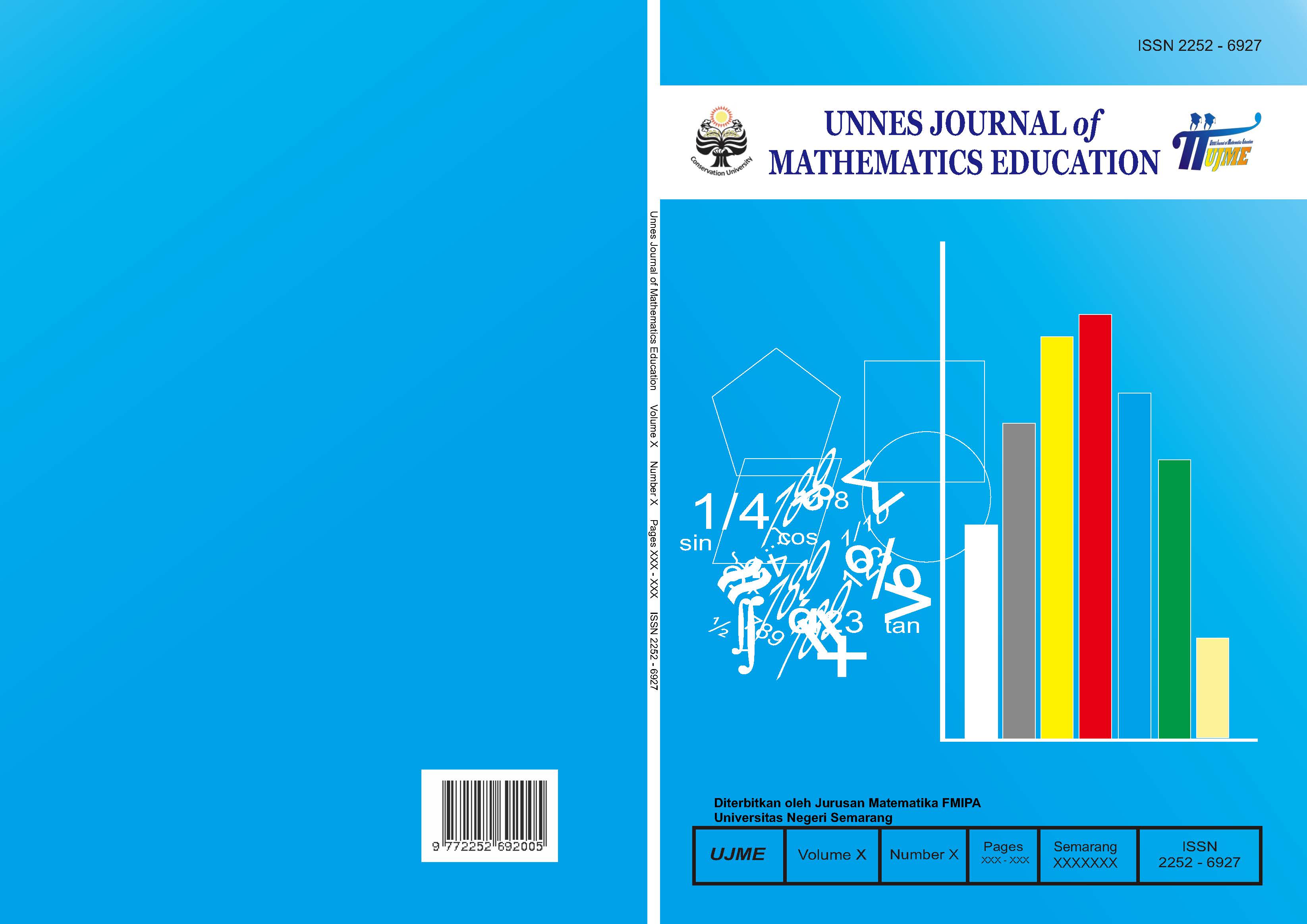Kemampuan Literasi Matematika Peserta Didik pada Pembelajaran Realistik Berbantuan Edmodo
##plugins.themes.academic_pro.article.main##
Abstract
Tujuan penelitian ini untuk mengetahui pembelajaran PBL dengan pendekatan saintifik realistik berbantuan Edmodo (PBL-PSR-E), pembelajaran PBL dengan pendekatan saintifik realistik (PBL-PSR) dan pembelajaran dengan pendekatan saintifik saja (PS) dalam meningkatkan kemampuan literasi matematika peserta didik; dan untuk mengetahui perbedaan rata-rata kemampuan literasi matematika peserta didik yang diberi ketiga pembelajaran tersebut. Populasi dalam penelitian ini adalah 270 peserta didik kelas VIII SMP N 21 Semarang tahun pelajaran 2015/2016 yang terdiri dari 9 kelas. Pengambilan sampel menggunakan teknik random sampling. Terpilih tiga kelompok sampel yaitu peserta didik kelas VIII H sebagai kelompok eksperimen 1,peserta didik kelas VIII I sebagai kelompok eksperimen 2, dan peserta didik kelas VIII G sebagai kelompok kontrol. Analisis data menggunakan uji gain dan uji one way anova. Diperoleh hasil bahwa penerapan pembelajaran PBL-PSR-E, pembelajaran PBL-PSR dan PS dapat meningkatkan rata-rata kemampuan literasi matematika peserta didik serta ratarata kemampuan literasi matematika peserta didik kelas VIII SMP N 21 Semarang menggunakan pembelajaran PBL-PSR-E lebih dari peserta didik kelas VIII SMP N 21 Semarang yang diberi pembelajaran PS tetapi tidak lebih dari peserta didik kelas VIII SMP N 21 Semarang yang diberi pembelajaran PBL-PSR.
The purpose of this study is to determine PBL with scientific realistic approach assisted by Edmodo (PBL-PSR-E), learning PBL with scientific realistic approach (PBL-PSR) and scientific approach course (PS) in increasing the average mathematical literacy skills of learner; and to find out the difference of the average in mathematical literacy skills of learners using those three learnings.The population in this study were 270 students in class VIII SMP N 21 Semarang 2015/2016 school year in nine classes. The sampling using random sampling. Voted three sample groups is class VIII H as the experimental group 1, class VIII I as the experimental group 2, and VIII G as the control group. Analysis of the data using the gain test and one way ANOVA test.The results indicate that the application of PBL -PSR-E learning, PBL-PSR learning and PS learning can increase the average of VIII grade SMP N 21 Semarang student’s mathematical literacy using PBL-PSR-E learning more than the average of VIII grade SMP N 21 Semarang student’s mathematical literacy that have been taught using the PS but not more than the average of VIII grade SMP N 21 Semarang student’s mathematical literacy skills that have been taught using PBL-PSR learning
##plugins.themes.academic_pro.article.details##
References
Arend, Richard. 2012. Learning to Teach, 9th ed. New York: McGraw-Hill.
Fauzan, A. et al. 2009. Teaching Mathematics in Indonesian Primary Schools Using Realistik Mathematics Education (RME)-Approach. IndoMS J.M.E Vol. 2 No. 2.
Kemendikbud. 2014. Materi Pelatihan Implementasi Kurikulum 2013. Kemendikbud: Badan Pengembangan Sumber Daya Manusia Pendidikan dan Kebudayaan dan Penjaminan Mutu Pendidikan.
Soviawati, Evi. 2011. Pendekatan Matematika Realistik (PMR) untuk Meningkatkan Kemampuan Berpikir Siswa di Tingkat Sekolah Dasar. Jurnal Matematika Edisi Khusus No. 2. ISSN 1412-565X
Sudjana, 2005. Metoda Statistika edisi 6. Bandung: Tarsito.
Tandililing, Edy. 2011. Implementasi Realistik Mathematics Education (RME) di Sekolah. Pontianak: Universitas Tanjungpura.
Wardono. et al. 2016. Mathematics Literacy on Problem Based Learning with Indonesian Realistic Mathematics Education Approach Assisted E-Learning Edmodo. Journal of Physics: Conference Series 693012014. http://iopscience.iop.org/article/10.1088/1742-6596/693/1/012014/meta. (Diunduh 16 Mei 2016).
